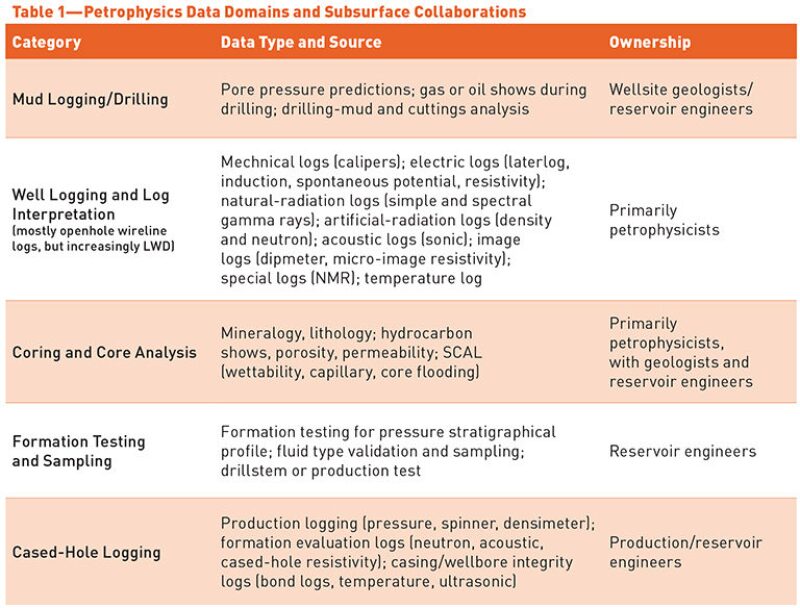Petrophysics is the study of the properties (physical, electrical, and mechanical) and the rock/fluid interactions of petroleum systems. In the oil and gas industry, the geologist and the geophysicist set out to define a reservoir prospect target from a structural perspective, while the petrophysicist fills in the details regarding the reservoir rock’s fabrics and fluid content. They achieve this by collecting data at the drilling stage using drilling, logging, coring, and testing tools for measuring—at bottomhole or surface—rock and fluid properties.
What Does a Petrophysicist Do?
The search for hydrocarbons begins with a regional understanding of the prevailing geology in a geologic basin, where the geologist gives an account of sedimentary sand deposition. After the geophysicist conducts seismic surveys and data processing, risky wildcat exploration wells may be drilled to test the best geological and seismic structural model. If a hydrocarbon discovery is made, data must be collected to evaluate the scale, quality, and quantity of the discovery.
The petrophysicist then steps in, performing tasks that have direct bottom-line significance. The petrophysicist needs to use all of the well’s directly measured data, which can be very limited, to construct as robust a reservoir model as possible. Table 1 gives a peek at the petrophysicist’s usual toolkit and job description, where every action item is about a direct touch with the reservoir rocks and fluids.

The petrophysicist participates at the drilling stage by examining rock chips and cuttings brought to the surface by the drilling mud and recording oil and gas shows at the borehole for all respective lithological and stratigraphic intervals. Then, logging-while-drilling (LWD) or a wireline-logging program, designed by the petrophysicist, is used. This should enable him or her to identify pay columns, differentiate oil-/gas- and water-bearing formations, and estimate porosity and hydrocarbon amount.
Because wireline logging means sending measurement equipment downhole—typically into a deep, dark, and dirty environment, where drilling mud causes near-wellbore invasion and logging tools suffer from problems of resolution, shallow reading, or ambiguous response—a hands-on approach with the rock fabric is required. The petrophysicist orders coring jobs and brings full-diameter core barrels or side-wall core plugs to surface. Core analysis is performed in a laboratory. Conventional core analysis not only validates lithological sequences and depositional environments but also gives details regarding rock mineralogy content captured in the prior log interpretation panel. Laboratory analysis of core samples also gives an independent assessment of porosity and permeability, which is used to calibrate log-based interpretation models. A typical product exhibits tracks of gamma-ray, caliper, and neutrondensity porosities; resistivities of different invasion depths; core porosity and permeability; and perforation recommendations. This leads to further evaluations of key pay intervals and estimations of their flow potentials.
If the discovery well’s preliminary assessment is encouraging, appraisal wells may be drilled to quantify the reservoir’s lateral and vertical extent. The petrophysicist will build crosssection models; delineate spatial distribution of each stratigraphic interval; and characterize the reservoir’s quality, extent, and integrity.
Only two technical numbers usually matter for oil companies—resource/ reserve volume and production output. The petrophysicist is expected to eventually help come up with the best estimate and sensitivity analysis of hydrocarbons-in-place, known as stock-tank oil initially in place/initial gas in place (STOIIP/IGIP). These estimates paint a picture of the reward size so business decisions can be made to either carry on exploration and appraisal activities or de-risk them by farming out. The STOIIP/ IGIP estimation exercise demands the petrophysicist’s best judgment on a handful of key parameters that speak for the reservoir—average porosity, pay column height (gross and net), initial hydrocarbon saturation, and fluid contact level.
Petrophysics vs. Formation Evaluation
For any discovered hydrocarbon volume, only the producible portion counts. This is where the petrophysics discipline meets the formation evaluation discipline. Addressing the producibility of part of or the whole reservoir and evaluating recovery efficiency ultimately provide values for the recovery factor and production output.
The petrophysicist provides qualitative descriptions of pay potential from log and core analysis. Routine core analysis identifies goodquality porosity, porosity types, permeability statistics, and possible natural fractures. Special core analysis (SCAL) offers details of capillary pressure behavior, wettability patterns, favorable/unfavorable production drive mechanisms, and laboratory-based recovery efficiency assessment under conceivable development options.
Even with the static nature of log interpretations and the lack of in-situ reservoir conditions in laboratory work, all the petrophysicist’s work is accepted by reservoir and production engineers, who turn to focus on the dynamic or flow nature of formations. A flow test is designed and carried out to observe the well’s flow capability and formation productivity index. Flow and pressure buildup data are analyzed. Good interpretations mean that the data from the flow test are explainable by the petrophysical view on pay thickness, average porosity, hydrocarbon saturation, reservoir container setup, and other descriptions.
Well testing is sometimes performed to detect the minimum connected drainable hydrocarbon volumes, if STOIIP/IGIP cannot be determined, in order to pass certain business hurdles. Such exercises require a tremendous integrated effort both from geoscientists and from engineers to reconcile and explain the volume differences between a seismic container and a hydraulically drainable compartment.
In order to optimize the development options of an established asset, the reservoir engineer builds a reservoir simulator with the petrophysicist’s entire data package, to forecast the number of wells to be drilled within the reservoir and their estimated production performance. The production output forecast, checked against the project economics and investment matrix, goes into development planning and reserve booking.
A Petrophysics Career in the Petroleum Industry
The early electrical logs run by brothers Conrad and Marcel Schlumberger in the 1920s provided the foundation on which numerous subsequent careers in log analysis were built. Petrophysics as a discipline was brought into prominence in the 1950s following a series of log and core work, such as that performed by Gus Archie, whose famous equation fundamentally transformed how we assess reservoirs. The 1970s oil crisis and the 1980s recession produced a severe drought period for oil industry professionals, leading to today’s oil and gas industry’s ongoing massive crew change, with the industry’s mainstay professional workforce going into retirement within the next 5 to 10 years, without enough new people to replenish them.
Another note is that, since the 1990s, the practice of petrophysics has been democratized because it was desired that most subsurface team members— geologists, geophysicists, and reservoir engineers—become petrophysics generalists. Cased-hole petrophysical experts are few and far between in the entire industry worldwide. This is creating a great opportunity for young petrophysics practitioners weighing their specialization interests before choosing career paths.
To be a petrophysicist, the most important thing in college is to have a solid yet broad understanding of major science and physics principles and concepts, because there will be plenty of opportunities to learn how to put these principles and concepts into use. In 2011, Shell Americas recruited professionals with a background in medical/hospital magnetic resonance imaging (MRI) to work as petrophysicists on difficult unconventional reservoirs. If today you are studying the Higgs boson, chances are that the particle physics background you have will allow you to better understand how neutron and hydrogen particles work in different logging environments.
It is highly recommended that you, as a young petrophysicist in the industry, find a mentor from among the most experienced experts in your company. Many distinguished petrophysicists from the last two generations are still actively engaged in consulting, training, and sharing their experience through the Society of Petrophysicists and Well Log Analysts, SPE, the American Association of Petroleum Geologists, academic communities, and private companies.
Oilfield service companies invent logging equipment hardware and provide data-acquisition services. A convenient roadmap is to start a career with one of the oilfield service companies and move on to oil companies afterward. Such a stay can get you up to speed and set you quickly on the road to becoming very knowledgeable. Operators then give you the opportunity to see the big picture and apply your skill set.
Since 2000, our industry has begun to explore and extract hydrocarbons in basins with distinct and extreme challenges: deepwater presalt, ultratight rock, thin-bed, coalseam, and gas hydrates. Activities in these plays have already led many professionals to rethink decades-old concepts, such as pay thickness or net pay. Revolutions in petrophysics interpretation and formation evaluation are anticipated during the next wave of industry transformation.

| Andrew Chen works with Shell Canada on various light tight oil and liquids-rich tight reservoir projects, including business development, exploration drilling, and asset maturation activities. He has more than 20 years’ professional industry experience at BP, AJM Deloitte, and Schlumberger, and as an international consultant. Chen earned BS and MS degrees in petroleum engineering from East China Petroleum Institute and a PhD in mechanical engineering from the University of Manitoba, Canada. |

| Ronald Pagan is petrophysics discipline leader at Shell Americas and manager of Shell Canada’s Early Maturation team. Over a more than 30-year career at Shell, he assumed various petroleum engineering roles in New Orleans, Oman, Canada, and the UK. Before his current roles, he was Shell Canada petrophysical technical chief (1997 to 2007). Pagan earned a BS in geology from Edinburgh University and an MS in petroleum engineering from Heriot-Watt University. |

